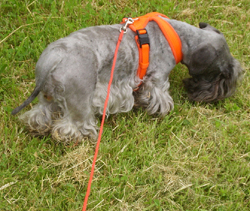Working

Temperament has always been important in this breed. The Cesky Terrier is very mellow, able to work well in a pack, and slow to anger. He has always been a family dog – as a breed they adore small children – but at the same time keen to go out into the countryside and assist in the day’s sport.

So what is it that makes the Cesky the ‘perfect’ terrier? Like most small terriers they will go to ground (so it is essential that they have a small, easily compressed rib) although they are slow to mature and often will not show any aptitude for this task until they are 4 or 5. They will work a hedgerow and put up a pheasant or a rabbit – and can be taught to retrieve.
But it is in the forest that the little Czech comes into his own. In the former Czechoslovakia, now split into the Czech Republic and Slovakia, it is the Wild Boar that is the major quarry. Boar hunting is a formal activity, with its own customs and even language. Horák’s kennel name ‘lovu Zdar’ means ‘good hunting’ and will be on everyone’s lips at the start of the day. Due to their sociable and biddable nature, this breed will work happily in a pack, driving the Boar through the forest towards the guns. They are also, due to their exceptional scenting powers, often used to track the Boar, following a live animal through the forest, and using their loud bark to alert the hunter when they are close up. They do not attack, obviously they are far too small to take on such a ferocious animal, but will dance around, using their agility to keep out of reach until the hunter can catch up and despatch the animal.

Int Ch Uff Laraff and his daughter Ch Nartoun Reca Diktatorka getting up close to a Wild Boar
Photo by Sabina Kocanová
.

In the UK we do not hunt Boar, but Cesky Terriers are proving their worth as deer tracking dogs. You can watch Anja tracking on this video.

Some Cesky Terriers like Bess (owned by Carol Adams) have learned to use those sensitive noses to search for truffles. You can learn more about Truffle Hunting here.

As an all-purpose hunting terrier, the Cesky can also work in the shooting field. Paul Cashin's Remi has shown herself to be a valuable member of the beating team.

This equable little terrier will work happily with other dogs and proves his worth as a worker in many ways.
Anja at a tracking day in Thetford Forest, working with a variety of other breeds
Lotus Zlata Chara and Nartoun Reca Amadeus
Photo by Vlastimil Durcík
